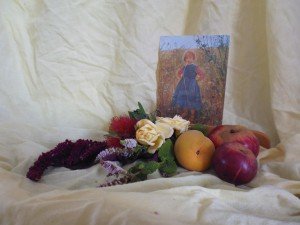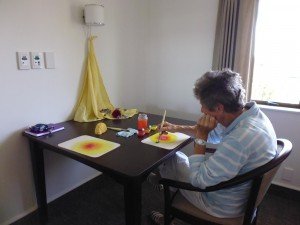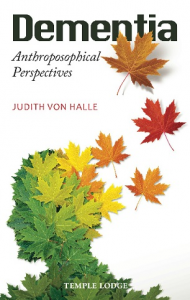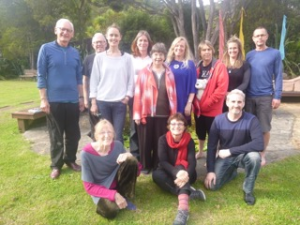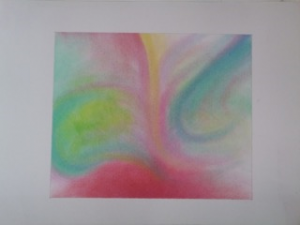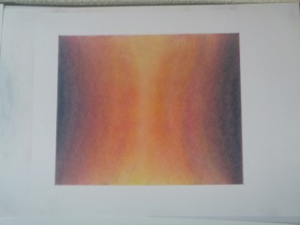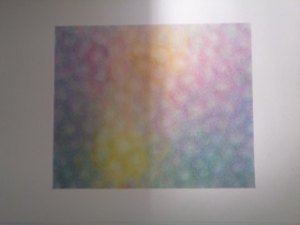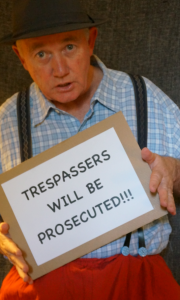
Top of The South Anthroposophical News.
Hello and Welcome to News/Views from our Anthroposophical world here at the Top of the South. I hope you will enjoy reading about what others are doing and that you can also participate in sharing Anthroposophically related issues.
Our starting theme is Dementia.
We are truly lucky to have this Article by Marije Laarakker – van oosterhout telling of the wonderful work she does here in Motueka. Rudolf Steiner called it…..’the work of the Angels’ and it surely is! This is followed by Gundula McKibben with an account of her recent attendance at an Art Meditation Retreat in Auckland. Enjoy!
Dementia care, challenging behaviour and Art Therapy at Woodlands
Holistic approach
The manager of Woodlands Oceania in Motueka has an open mind toward a different and more holistic approach of care for people in the rest home and particularly for the people who suffer from dementia in the recently opened Nikau wing.
As an Anthroposophic Art Therapist Diversional Therapist and experienced caregiver, I am involved in the development of activities offered to the residents of this dementia ward.
Person centered care
All staff provides person centered care, focused on the individual needs of each resident and must follow the guidelines of the Code of Rights as established by the New Zealand Health and Disabilities Commissioner.
Although the principles of the Code of Rights are very clear, caregivers often find themselves in a grey area when caring for people suffering from cognitive impairment.
They need to weigh different aspects of a decision very carefully before acting and ensure it is in the resident’s best interest, realising and accepting it may differ from their own beliefs, values and perspectives.
A person with severe dementia can be confused in time, place and/or person.
They may interpret a situation or an event with a view that often seems unrealistic or incomprehensible for the people around them.
A daily event may be coloured by memories as the person sees with eyes from their childhood, or another era in life: a very busy person wandering through the facility, commanding others with orders or constantly checking the drawers and cupboards, may in his minds eye still be managing the business floor of a company he used to work for.
This unsettling behaviour can easily trigger irritation in staff or other residents and untrained or unexperienced staff may try to sit the person down. Soon enough they will realise that stopping someone from showing unwanted behaviour doesn’t work when they don’t understand what is going on underneath the surface. Trying to stop repetitive behaviour usually has the opposite result. Staff need to find the key to divert the person and to resettle him. But usually the best thing is not to give it any attention and let the person do his business, as long as it doesn’t hurt or harm others or himself.
Looking for unmet needs
The good intentions of a caregiver wanting to change a soiled continence product, can be wrongly interpreted, or their actions may be experienced by the resident as inappropriate or intimidating, for which the person understandably tries to protect himself.
The caregiver has to accompany all actions with an explanation and non-verbal expressions that the person on their cognitive level can understand and that make them feel safe, respected and loved.
The caregiver needs to balance out whether the cares are more important at that moment in spite of what the resident has to go through, or whether it can wait until the resident has settled and the anxiety levels have dropped.
Often an event seems to trigger behaviour that doesn’t make any sense to us and the reaction seems to be totally out of proportion.
One moment a person with dementia can smile and follow the instructions given, the next moment their mood changes, agitation levels rise and result in verbal or physical aggression.
It is important for a caregiver to search for the reason behind this behaviour. Usually the behaviour is the only way left for them to express themselves.
When searching for the cause of change in behaviour, we often discover a basic need that is not met.
It may well be that the person needs the toilet, is thirsty or hungry, or needs a rest.
Brain fatigue is often an underlying condition for agitation and anxiety.
This may be one of the causes for the “sun down” phenomena, when some residents get restless and wanting to go home in the afternoon.
A force from within somehow seems to trigger the urge to go home to start cooking, or to care for the children returning from school.
Life history
It is very important to build up a personal rapport with each resident and to learn about their life’s history.
What they have done, how they have lived, what they have experienced in life can be used as an ice breaker, as a key for contact, but also to understand where certain reactions may come from.
Aggression is often an indicator for experiences of fear or suffering in the past, or for fear of the unknown, which they experience when they don’t understand what is expected from them for example when they don’t understand the instructions given.
Validation
Experience and studies have proven the importance of validation of the mood, behaviour or experience as described in the Validation Breakthrough by founder Naomi Feil.
In the advanced stages of dementia it is no longer necessary to bring the person back to the present moment or our reality of things, or to correct their thinking or experience of a situation.
They will not fully understand and they will not remember it, since the brain, the instrument for retrieving memories, is impaired.
It can be very frightening for a person to learn that their partner died years ago without them knowing this.
To go through the mourning and grief for the loss over and over again must be unbearably painful.
Correcting their thinking will trigger feelings of failing and being misunderstood which results in agitation and aggression, or in depression and withdrawal. For it is the reality they are in at that moment and that needs to be respected.
It is very important for the caregiver to gently move into their world, and work from there.
On the threshold where caregiver and resident meet things can move.
Acceptance of their reality is of great importance.
When they can experience trust, genuine acceptance, respect and love the person suffering from dementia in general will be much more settled.
Extended family
The caregiver need to become like an extended family member, especially in times when family members find it hard to visit their loved ones.
Sometimes exhaustion and despair amplify the feelings of guilt and failure when their partner or parent moves into a residential facility.
All staff needs to care for the family too, to ensure them that it is alright to pass some of the care over, but also to encourage them to stay involved as much as they want and can.
Art Therapy and dementia
Art Therapy sessions are held in a small activities room.
I usually tidy up the games, toys and magazines to create a nurturing and intimate space in which the residents will feel comfortable and safe but not having to deal with too big of an environmental change.
I make a small season table with different elements from nature, a picture or card to set the theme or atmosphere for the session.
Not all residents want to do Art Therapy, it makes them feel uncomfortable.
Before I invite a resident for a session, I introduce myself and sit with them for a chat, I offer them a cup of tea or hold their hand, until I feel that they are comfortable in my presence and a rapport has been established between us.
Some residents respond well to the question to come with me for a session, but for others too many words are overwhelming as they quickly lose the threat of a sentence. They will certainly answer with ‘No’ for then at least they don’t have to do what they didn’t understand. A simple “Come with me” is sufficient for them to accept the offered hand and follow me to the therapy room.
As the person’s mind is not always in the present or focussed, or the person is easily distracted with something else, for example with a bird outside, or the tissue on the table, it sometimes seems that all explanation is in vain.
But more often I am surprised to see the intention I had for the session somehow being worked out on paper by the resident.
Until now the residents have only used the wet-on-wet painting, as I feel it is very proporiate for the atmosphere they are in.
I accompany the painting with a verse, poem or a song. Music is one of the last abilities to disappear in a person with dementia; it can be used as a bridge to their soul.
People who have lost their speech to dementia, are sometimes still able to sing songs and to retrieve the words without any problem even when they don’t talk anymore.
Therapeutic stroke and nurturing the soul
Most the painting exercises are done with the ‘therapeutic stroke’ the calm and gently stroking of the paper in an opening stroke depending on which hand the person uses. With the right hand the stroke will go to the right. This movement opens the heart and lung (rhythmic)area and allows things to flow.
The flow of the exercise soothes and calms the person. I have seen the superficial almost hyperventilating breathing of a resident calming down, allowing her to breathe more deeply and thus being more present and engaged in the excercise.
Another exercise is spiraling from the externity of the paper to the center. This is a centering, focusing exercise with a deep effect on physical, etherical and spiritual level.
In the painting sessions I won’t focus on the forces that are receding due to dementia, for example the I-forces.
Addressing the withdrawn forces too directly could provoke confusion, agitation and feeling of failure. Of course this is the opposite of what the therapy for people suffering from dementia aims for, so the exercises rather concentrate on the remained forces, which for each individual is different.
Nurturing the soul by bathing the astral forces in color is another purpose of the therapy.
Images
Very interesting images show in Art Therapy.
In general people suffering from dementia seem to find it difficult to fill the entire paper with color.
The paintings show holes or gaps, or one side of the painting seems to be ‘forgotten’.
This shows how the I-forces are fluctuating, unable to fully engage and get grip on the other force bodies to create an image with the physical body.
Wet-on-wet painting exercises work very well to activate the ether forces and fill in empty spaces.
Honored
Not all residents want to do a session every week, and the limited time doesn’t allow for all residents to have one, which makes it harder to really embark on a therapeutic journey with greater effects, but the simple ‘social hygienic exercises’ as practised in the Art Therapy sessions already have a significant and positive effect on the mood and behaviour of the residents. Even when it is just for that short moment.
For me as Art Therapist, Diversional Therapist and caregiver I am honored to provide activities to the residents to make them feel and experience that they belong, that they have purpose and that they still are needed and loved, even in this estranging environment where nothing seems to make sense to them all the time.
References
- www.hdc.org.nz/the-act–code/the-code-of-rights The Code of Rights
- Naomi Feil The Validation Breakthrough – simple techniques for communicating with people with Alheimer’s type dementia
- Jan Pieter van der Steen Dementie – Achtergronden en praktijkervaringen
- www.dementiacareaustralia.com the Spark of Life approach
- www.alzheimers.org.nz Alzheimers New Zealand
About the author
Marije completed four years of full time study for Anthroposophic Art Therapies at Leiden University, Netherlands, in 1998.
For three years she had her Art Therapy practice in the Tobias School in the Netherlands, a Waldorf school for children with special needs.
She also combined Art Therapy and social work for clients and their children at the social care unit of a small community in the red light district of Amsterdam, and held Art Therapy sessions with homeless drug addicts suffering from Aids, at a care unit of the Salvation Army. After moving to New Zealand in 2009, she worked as a caregiver and Art Therapist in another facility, before becoming Diversional Therapist, Art Therapist and casual caregiver at Woodlands Oceania in Motueka.
***
Book review
Dementia
Anthroposophical Perspectives
By Judith von Halle
Translated by Frank Thomas Smith
Judith von Halle is mostly known for her books and lectures about the life and meaning of Jesus Christ. In this book she concentrates on a medical phenomenon which today has taken on the characteristics of a plague. Senility, involving short term memory loss and the general weakening of mental faculties associated with old age, has been known for centuries, but the illness we now call dementia or, in its more extreme stages, Alzheimer’s disease, has become more and more prevalent in modern society. Not only the aged are affected, but symptoms have been detected increasingly in the middle-aged, even in children. Before going further, it should be noted that there is a difference between “normal” old age forgetfulness and the illness which can lead to the affected persons becoming little more than living vegetables. The former is benign, the latter devastating.
In her introduction von Halle describes why she decided to expand the first edition of this book, which was directed to readers who were familiar with anthroposophy and its terminology. When she was invited to give a talk at a Swiss retirement home, where many of the listeners would have little or no familiarity with anthroposophy, she decided to first give a basic overview of anthroposophical concepts before going into the details concerning the nature and causes of dementia. After her talk, members of the audience, both those with no previous knowledge of anthroposophy and even anthroposophists, told her that the inclusion of her explanation of anthroposophical concepts made everything much clearer. So for the new edition she decided to include the explanation. I won’t blame anyone for thinking that as the translator of the book I may be prejudiced. However, I can honestly say that one of the reasons for which I offered to translate it was the clarity and conciseness of this short explanation in the chapter What is the Human Being, which begins:
“…Such consciousness about the human being, his true inner and outer nature, can be acquired if one begins to consider him – which is, after all, his own being – with the methods of anthroposophical spiritual science. Practicing anthroposophical spiritual science is possible for everyone. No special qualifications are needed. By being human one is qualified. For it is not at all the task of anthroposophical spiritual science to investigate the spirit, but by means of the spirit to investigate the world and humanity. The fact that this spirit is available to the human being means that we are – without any kind of specialized training – very well equipped for anthroposophical investigative work, provided that we are really willing to do so.”
And ends with the paragraph:
“Given that man is a spiritual being with a physical body, it is obvious that the causes of an illness are not to be found in the physical context, but rather the physical breakdown is recognized as the impulse of spiritual causes and these causes are to be sought within the spiritual components of the human being.”
One of the first symptoms of dementia is memory loss. Von Halle goes on to describe how memory is a collection of remembrances and where and how they are collected in the human psyche, and once collected, or inscribed in the life-body, why it becomes more difficult, because of this illness, to retrieve them.
There are short-term and long-term remembrances. The author uses the image of a tree-trunk and its various layers to explain where they are stored:
Thus we can at least imagine why the different types of memories are on one hand more permanent and others less so, and on the other hand more – or less – , difficult to extract when desired. And how this affects people afflicted with dementia.
“That ever more people in western culture are stuck in the decay of their material nature is because they do not fill the gaps left by the physical decline in the fabric of their being with such spiritual thinking. This means that the decline of material nature – for example the dying of brain cells – would not necessarily be problematic provided that the human being has timely developed something capable of taking their place. This was the purpose of the Mystery of Golgotha, to bring the human being to a stage equal to that of the Resurrected One on Easter morning, namely to create an non-decomposable physical body through his I-forces, a no longer mineral-physical, but a spiritualized physical body.”
Judith von Halle later describes the role the spiritual opposing forces play in the phenomenon of dementia. Lucifer strives to cause human beings to lose their footing on the earth, to “gawk at nirvana”, whereas Ahriman wants the opposite: materialism, the denial of the spiritual world and of the spirit in man. Therefore, she says, it is an error to think only in terms of good and evil, because Lucifer and Ahriman, spiritual beings themselves, are actually opposed to each other. The spiritual scenario is, in reality, a trinitarian one, with Christ in the middle opposing the evil on both sides.
This does not mean that the individuals suffering from dementia are necessarily materialists, or the opposite. Rather, dementia is a plague of humanity as a whole. But who has it and who doesn’t isn’t a roll of the dice either. The determining factor is karma.
“In general we can understand the outbreak of a certain illness in an individual as the expression of a karmic cause. From spiritual science we know that the disposition to the development of an illness reflects the result of certain behavior, of deeds in a previous life. Nevertheless, we should not ignore the fact that an illness is not sent by the opposing powers. It is we ourselves who really bring it about, but it is the good divine spirits who convert our karmic behavior in a previous life to a special “task” in the present life in order to give us the opportunity to grow by means of this task. The individual’s illness, whether it be the flu or a heart condition, is caused by his moral biography during the previous incarnation. So-called risk factors, which may really precede the illness, merely display the instruments, the “helpers” that cause the karmic illness to break out in this life, so that a healthy balance in the soul can be attained.”
However – and here’s where it gets complicated:
“If we understand the illness of an individual as a karmic necessity, then the same illness in the many must be the result of a shared karmic necessity. It is then not a question of an individual destiny, but of a people’s or even humanity’s destiny, for the karma of humanity, which must be resolved, also exists.”
Therefore, dementia, when understood as a plague, may be related to individual karma as well as a shared human karma, also involving individuals whose previous personal karma is not the cause. This is also true in the case of natural disasters, tsunami and the like.
“The illnesses which the people of the west must increasingly fight against, and which are not of a karmic nature – at least not of an individual karmic nature – are directly related to the illness of the social organism, that is, to the unrealized spiritual and Christian-moral goals of today’s civilization.”
The author goes into considerable detail about the influences of individual and human karma. In respect to what is called above the “illness of the social organism”, she reminds us that dementia – “de-mens”, “without spirit” – describes precisely the current state of our western culture, and quotes Rudolf Steiner:
“Whoever sees through these things will of course not take them as a reason for opposing modern medicine with its external remedies. But a real improvement will never come about through these external methods. What will come about later always reveals itself in advance through esoteric knowledge. This consists of rightly perceiving how morality in the present can lead to better health in the future.”
If the human being is considered to possess only a physical nature, or when his spiritual components are ignored, and his illnesses are treated using physical diagnostic methods alone – changes in the brain’s structure, for example – the spirit is unable to vivify the physical body, thereby maintaining or restoring its healthy stability, and only the symptoms are treated. By changing our conceptions of what the human being really is, however – that is, consisting of body, soul and spirit – real progress can be made in understanding an illness such as dementia, and illnesses in general. Judith von Halle concludes that this can be accomplished through anthroposophical spiritual science.
As far as Ahriman’s role is concerned, she describes it as follows:
This process [the weakening of the human I] is Ahriman’s great plan, or that of even higher dark powers, to prevent the human being from envisioning the Christ-Being in the etheric world that surrounds and permeates our sensory world, and to utilize this envisioning as a foundation for spiritual and physical development. It is truly an anti-Christian struggle against humanity’s general awakening to living remembrance. In this way Ahriman tries with every means to take away man’s conscious control of his remembering process. He uses our comfortable materialistic thinking for this. But materialistic thinking is only the instrument for carrying out Ahriman’s plan to prevent humanity from achieving wholly conscious living remembrance, and he possesses an ice-cold, genial ability, added to the previously described processes which are responsible for the dementia phenomenon. They are all means helping to carry out this anti-Christian plan in the realm of matter, one coming from the spiritual world that works into the sensory world.
As a professional architect, Ms. Von Halle is well qualified to suggest what kind of surroundings are most useful in designing the living quarters for dementia afflicted patients in residential institutions. It is beyond the scope of this review to go into any detail here. She also indicates what kind of people should be entrusted with the patients’ care:
“Caregivers would have to be found who consider it their life’s mission and their destiny’s vocation to be constantly together, at least during a part of their lives, with one, two or three dementia patients, and not as a passing fulfillment of duty in a stressful job. This can only happen out of real love, as a sacrifice not accompanied by inner discord. During the candidates’ interviews it would have to be decidedly emphasized that only people with this attitude be accepted in the assisted living plan.”
He or she would also have to be competent enough to carry out, or at least supervise, the artistic activities which Ms. Von Halle recommends.
All this, as the author admits, would be a difficult and expensive undertaking. Nevertheless, considering that the dementia afflicted are people who have been affected by life, who at the point in their lives when the strongest I-forces should have been developed, they have completely withdrawn, its seems to me that even the knowledge of such requirements can be helpful.
In concluding this review, it is, I think, appropriate to quote Judith von Halle’s concluding paragraph:
Thus in a culture influenced by Ahriman, the Christian forces of compassion, endurance and love, although scarce, can be lighted anew, for it has been shown already how, in company with the dementia afflicted, these attributes of the caregiver lead to very beneficial effects – for the ill person as well as for the caregiver. This moral attitude would not only have a positive influence on the following generation and lead to a certain implicitness in care-giving work, but the prevalence of the illness itself would be limited from the outset by such a standard. Thus from an evil a good could arise – as in Mephistopheles’ motto in Goethe’s Faust: “I am a part of that force that always wants evil, and always creates the good.” – which can bring humanity a step further in its long and arduous path to becoming gods through the impulse of Christ.
****
Rudolf Steiner on ‘the weak head in old age’
And so, gentlemen, if — for instance — a child is becoming weak in his head — inattentive, hyperactive — he will usually have a corresponding symptom: worms in his intestines. Worms develop easily in the intestines if the head forces are too weak, because the head does not then work down strongly enough into the rest of the body. Worms find no lodging in a human body if the head forces are working down strongly into the intestines. You can see how magnificently the human body is arranged! — everything is related. And if one’s child has worms, one should realize the child has become weak in his head. Also — whoever wants to be a teacher has to know these things — if there are persons who at a later age are weak-minded, one can be sure they have had worms when they were young.
And so what must one do if one observes this in the child? The simplest remedy is to give him carrots to eat for a while — with his other food, of course; naturally, one couldn’t just feed him on carrots alone. Carrots are the root of the plant. They grow down in the earth and have a large quantity of minerals. They have the forces of the earth in them, and when they are taken into the stomach, they are able to work up through the blood into the head. Only substances rich in minerals are able to reach the head. Substances rich in minerals, root substances, give strength to a human being by way of the head. That is extraordinarily important. It is through carrots that the uppermost parts of the head become strong — which is precisely what the human being needs in order to be inwardly firm and vigorous, not soft.
– See more at: http://wn.rsarchive.org/Lectures/GA354/English/AP1987/19240731p01
***
Again, Rudolf Steiner’s words are confirmed.
“Everything connected with medicine will make a great advance in the materialistic sense. Men will acquire instinctive insights into the medicinal properties of certain substances and certain treatments — and thereby do terrible harm. But the harm will be called useful. A sick man will be called healthy, for it will be perceived that the particular treatment applied leads to something pleasing. People will actually like things that make the human being — in a certain direction — unhealthy. ” R. Steiner.
See more at: http://wn.rsarchive.org/Lectures/WrkAng_index.html…
How brain chemistry influences compassion
***
The Art of Meditation
Remember to come and bring your friends to Michael’s public performance …
SHAKESPEARE AND THE MYSTERY OF THE HUMAN BEING
This one-man performance looks at Shakespeare from the point of view of the bard’s relevance today – in particular in highlighting the challenges of what it means to become an authentic person in a world that attempts to fool us with falsehood or push us towards conformity. Through seventeen different excerpts from Shakespeare’s plays (with Hamlet the most used) and an ongoing commentary linking them together, Burton unfolds his meditation on what it means to be a human being.
When we watch Shakespeare we see humanity; we see ourselves. Spending time with him, a person can simply be entertained or can become a truer copy of their real Self.
The five public performances will take place in Auckland, Hastings, Wellington, Christchurch and Motueka. Shakespeare and the Mystery of the Human Being will also be done at the Kolisko Conference at Cambridge in July.
Motueka. Wednesday 27th May.
At Chanel Arts – contact the Motueka Rudolf Steiner School
Michael always brings joy and knowledge.
A MUST SEE.
also….
WORKSHOP WITH MICHAEL BURTON
– on Rudolf Steiner’ s first Mystery Play ‘The Portal of Initiation’
Date: May 25th Place: Motueka Rudolf Steiner School
Time: 7.00pm – 9.00pm Cost: $25.00
Rudolf Steiner’s work included four dramas (mystery plays) created during arts festivals in Munich in 1910, 1911, 1912 & 1913. These dramas show the destiny elements for a constellation of characters through multiple life times, from Ancient Egypt, through Hibernia, the Middle Ages, and into the early 20th century. THE CLARITY of understanding of the formative forces of destiny (karma) and the central questions of esoteric Christianity make these works unique in human history.
Michael Burton, is an actor, poet, playwright, speech therapist from Australia.
He has over 30 years experience in Waldorf education, speech and chirophonetics therapies, speech teaching and acting.
He is part of a group of artists who produced these mystery dramas in the English language and toured throughout the northern hemisphere during the 1980’s and 1990’s.
The same group is coming together again to work on a new play based upon the characters and events of the first four plays called ‘The Pathway’.
The workshop will be open to anyone interested in working with Steiner’s mystery plays.
Our Motueka Anthroposophical reading group will follow this workshop by studying the ‘The Portal of Initiation’. We welcome anyone interested in joining us.
If you are interested in the workshop please reply to: [email protected] or 03 5288686
AROUND THE TRAPS
- The Nelson reading Group
meets fortnightly on Thursdays at Unit 1, 114 Tasman Street, Nelson from 7.30 – 8.30pm. . We have been delving into the Karma lectures and this Thursday we will begin reading and discussing the lectures Steiner gave about Anthroposophy in Everyday Life. These lectures are called: Practical Training in Thought, Overcoming Nervousness, Facing Karma and The Four Temperaments.
We have between 5 and 8 people who attend regularly.
- Anthroposophical Therapies
A bunch of people who are practising therapies that come out of anthroposophy have been meeting to plan a therapy workshop in June. The theme of the workshop is “Sleep”. Therapies currently available to the wider community include art, music, biography, movement-based and nursing. [email protected]>
- The Motueka reading Group
meets fortnightly on Thursday. On the 19th March we will be working on preparation for the Easter Festival planned for 5th April. Thursday 16th April we will return to the third in a series of lectures “Memory and Habit” by Rudolf Steiner. Around June we are considering reading the Mystery Dramas written by Rudolf Steiner. New members are always welcome. [email protected]>
***
SureFire Kindling
Support the School. $5 box….from School.
Excellent value!
****
Please feel free to forward this to anyone you think may be interested.
Anne Perry, caretaker editor.
